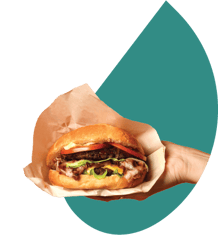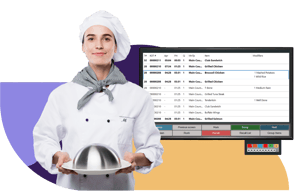How the self-service trend is transforming restaurants

The modern consumer places huge value on convenience. A recent report by the National Retail Federation found that 97% of consumers have backed out of a purchase just because it was inconvenient for them. And in quick service restaurants, figures show that lengthy queues can be off-putting: almost three out of four guests say they would leave if there were seven people in line. More than nine out of ten said they would go elsewhere if there were more than 10 people queuing before them.
Taking the example of supermarkets, which have successfully alleviated queues with self-service checkouts, fast food brands are now adopting touch-screen self-service kiosks. And as more report the positive impact of these kiosks, adoption is rapidly taking off.
The rise of self-service kiosks
McDonald’s now has self-service kiosks in all 14,000 of its US restaurants. When it began rolling them out in 2017, it said its intention was to enhance the customer experience by speeding up ordering time, reducing human error and allowing for easier order customizations.
McDonald’s is living proof of the success of self-service kiosks. CEO Steve Easterbrook said the chain is seeing impressive incremental sales rises from its use of kiosks.
“As we convert the restaurants, we’re getting an incremental sales lift from that, some of which will come through growing and increasing use of the self-order kiosks where we generate higher average checks,” he said.
Interestingly, not only are self-service kiosks delivering on consumer desire for ultimate convenience, they’re altering behavior too. As the use of the technology grows, self-ordering has been demonstrated to boost sales by increasing the average order size per customer, while at the same time lowering costs in the restaurant by improving efficiency.
There are some compelling statistics to illustrate the impact. When the Dodgers Stadium concession stands in the US tried out new self-service kiosks, the average order size increased by 20%. Similarly, Subway noted that kiosks encourage more consumers to purchase add-ons and generally spend more.
Why? Perhaps because allowing customers to have their ordering decisions at their fingertips empowers them.
Let’s compare the conventional ordering process to the new automated process to see how it works…
The traditional experience
Lee heads to his local Easy Burger for lunch. He isn’t a regular customer so he doesn’t know the menu well. It’s a busy Friday afternoon in the restaurant and as he joins the queue he starts scanning the menu board behind the counter to see what he would like. When he gets to the front, he still isn’t quite sure what he wants and spends a few more moments deciding. By this point he’s a bit flustered. He doesn’t want to hold up the queue, so he quickly orders the standard burger meal with no cheese and large fries. It’s noisy in the kitchen, and the server asks Lee to repeat his order. She presses the buttons on the cash register to input Lee’s choice, and politely waits for him to decide which drink he’d like before finalizing the order and taking his payment. This all takes place in the midst of noises coming from the kitchen, voices of customers waiting, and general pressure from people standing in line waiting for their turn. It’s clear to see that there are several opportunities for mistakes, delays and general frustration from both the customer and the cashier.
The self-service experience
What would the same scenario look like with a self-service kiosk? Again, Lee heads to Easy Burger to pick up his lunch. It’s busy, but Lee heads to a self-service kiosk, where he doesn’t have to queue to place his order.
Lee hasn’t actually used one of these kiosks before, but because it looks just like a large version of his mobile phone and all the menu items are clearly labelled, he has no qualms about trying out the technology. With nobody standing behind him putting pressure on him to quickly place his order, Lee feels he can take the time he needs to choose his lunch. He scrolls through the menu and takes in the appealing pictures of food, drinks, and add-on items. He ends up trying out a new meal deal and customizes his burger (no pickles, extra onions and mushrooms), adding the curly fries with cheese – they look too good not to try them. It’s a pleasant, stress free experience.
After selecting the items, Lee taps his credit card on the contactless card reader and heads to the counter to wait for his order. He can clearly see his order on the screen above him, so he know there are five orders before his – a bit of a wait, but not too much, before it’s ready. A few minutes later, his number is called out. He picks up his food and heads straight to a clean, empty table. That’s another added bonus. With fewer employees required at the counter, they can spend more time in the kitchen, speeding up food preparation, and on the floor, making sure the restaurant stays clean and tidy.
Embracing the trend with LS Central
Restaurants are embracing the trend in different ways. Some are buying self-service kiosks running systems and interfaces separate from what is used across the rest of restaurant. This decision entails a lot of extra work, as these systems will have to be integrated with the IT setup, and then updated and maintained individually over time.
Thankfully, there is another option. If you selected a unified restaurant management solution like LS Central for restaurants, you enable customers to order and check out for themselves using the exact same POS system that cashiers use at the manned tills. This wouldn’t be possible with many other restaurant management systems because they are too complicated, and can’t be used effectively without previous training.
Not LS Central.
There are more benefits, too. You can easily amend and customize the looks of the kiosk to suit your needs. Just as you would customize the POS, you can change interface and menu options to suit your branding, and apply the changes across all your locations – no headache of setting up the brand look for each individual kiosks.
Simple menu customization also means you have the freedom to A/B test ways to present the menu to see what works best and yields the greatest results. When you get smart about how you showcase your menu, you can capitalize on more upsell and cross-sell opportunities and promote the higher margin menu items. Perhaps you choose to highlight your latest meal deals on the top level of the screen or maybe you collapse certain menu choices at different times of the day to speed up the ordering process.
Digitalized self-ordering also helps you to manage your inventory proactively. So, if you find that beef burgers are running low, but you have plenty of chicken burgers available, you can quickly change the menu on the machines to highlight mouth-watering chicken burgers on the first-level menu instead. Or perhaps your smoothie machine breaks down: instead of striking a line across the item, you can temporarily remove those items from the menu and highlight alternatives such as milkshakes and ice creams.
Making a difference in the kitchen
This streamlined, user friendly experience transfers into the kitchen too. Orders are automatically sent to the kitchen display system (KDS) and presented clearly to your kitchen staff. The system can further help improve efficiency by routing orders to the proper food preparation stations, organizing items so they are prepared in the right order and ready at the same time, and alerting staff when orders have been in the queue too long. At the same time, front-of-house staff (and customers) can see the exact status of each order and pick them up as soon as they are ready.
Setting your restaurant business up for long-term success
Despite the current success of kiosks, many restaurateurs wonder whether this is just the flavor of the month. Will kiosks still be popular with consumers another year or two down the line? While we can’t predict the future, we can see that the big brands have been cautious. A quick service restaurant expert and Forbes contributor wrote an article in 2010 called “Quick-service restaurant kiosks: What’s taking so long?” One reason why we’re seeing wider adoption now is because the technology is proving its success.
As kiosk usage rises, customers will increasingly expect to find self-ordering options in fast food outlets. Research shows that customers are more likely to visit restaurants with self-service kiosks and a growing number prefer this option to interacting with a cashier behind the counter.
As more diners seek ultimate convenience, faster ordering and more payment options, self-service kiosks are proving the best solution to meet their demand and enhance the transaction journey from start to finish.


